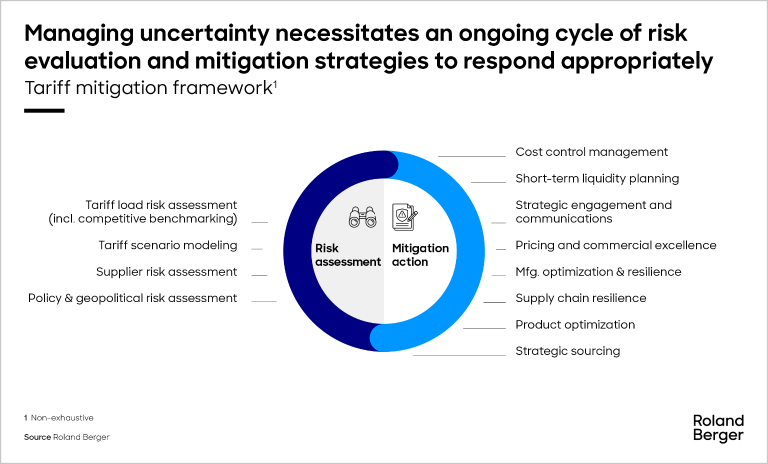Donald Trump's re-election may result in policy shifts in trade, energy, and regulations, necessitating that businesses adapt and reassess strategies, including potential mergers and acquisitions.


Navigating the tariff storm
By David Born and Christian Krys
How to protect your business in turbulent times
Last updated July 17, 2025
US President Trump’s tariffs represent a significant shift in US trade policy. What some observers characterize as impulsive decisions actually appear to be part of a coordinated approach to restructuring international economic relationships.

The new tariff regime, announced on what the Trump administration termed "Liberation Day" in April, applies broadly across the global economic system and signaled a departure from decades of established trade practices. These measures were reportedly developed over several months with input from key economic advisors including Stephen Miran and Peter Navarro.
While initial speculation over the impact of the tariffs has dominated headlines, Trump’s new tariff system marks the starting phase of a broader effort to reshape the international economic and monetary order.
In this article, we will outline the underlying rationale behind Trump’s economic policy and look at the potential threats this approach poses to businesses around the world. Finally, we will demonstrate how Roland Berger can support your company both in assessing associated risks and developing corresponding mitigation strategies.
What is the rationale behind the tariffs?
Trump’s fixation on what he sees as an unfair global economic order is driven by a vision of revitalizing the US manufacturing sector. He also believes – perhaps rightly – that his supporters now expect a bold and determined effort to fundamentally reshape a global economic system they perceive as harmful to American industry.
The four main objectives of this new tariff regime can all be traced back to Trump’s fixation on trade imbalances and his perceived mandate to deliver on campaign promises.
These objectives are:
- Eliminating trade deficits by raising US tariffs
- Halting what is seen as unfair competition from key global rivals
- Sparking a "renaissance" in US-based manufacturing by reshoring production
- Increasing government revenue through higher import duties
Trump’s tariffs not only exceeded expectations in scale; they also introduced a highly unconventional methodology. For each country or economic bloc, a so-called "reciprocal" tariff was calculated. For instance, the EU was initially assigned a 20% tariff – half of 39%, a figure derived by dividing the US trade deficit with the EU by total US imports from the EU. This approach entirely ignores existing trade barriers and results in measures that were far from genuinely "reciprocal" or "symmetrical."
Having reached only a handful of agreements ahead of the self-imposed deadline, Trump has since continued to threaten higher tariffs for the EU and other markets.
"Due to the tariff storm companies face significant uncertainty and risks; they must prepare for the new situation to make their business resilient."
How great is the damage (for now)?
What will be the macroeconomic impact of these tariffs and the potential cycle of retaliatory measures? At this stage, it is difficult to say. What is clear, however, is that policymakers in China, Europe and beyond believe they have tools at their disposal that can inflict real damage on the US economy in response.
But even in an optimistic scenario, the result remains clear and measured: The dominos have already begun to fall. Preliminary scenario analyses incorporating the current tariff dynamics indicate that the renewed trade conflict is likely to have severe adverse effects – not only for China and Europe, but also for the United States.
In the US, leading indicators that signal the risk of a recession increased significantly after "Liberation Day." They fell again after the announcement of the tariff pause with China. The US economy is expecting upward pressure on inflation, as firms with strong pricing power could pass through tariff-related costs to end consumers in an effort to preserve margins. The "Liberation Day" announcement also triggered a record plunge in US stock markets and wiped trillions off Wall Street, impacting the more than 60% of American adults who hold stocks. Although stock markets recovered after tariff pause announcements, uncertainty is still high. Bond rates increased, showing that investors were losing confidence in the world's biggest economy.
The economic fallout will not be confined to the primary actors. The unpredictable nature of the tariff policies poses a significant threat to global economies. Market volatility severely hampers corporate decision-making and strategic planning. Traditionally, governments aim to create stable conditions for businesses but in this case, the US political sphere itself is the source of uncertainty . For example, the European Union, whose largest export destination remains the US, is projected to face meaningful GDP headwinds should the dispute intensify.
This should come as no surprise. There is even a historical "blueprint" for the economic damage we are now witnessing. The negative effects of global protectionism were already highlighted by the Smoot-Hawley Act of 1930, the last major American "tariff offensive." This global trade war at the beginning of the 1930s was detrimental to everyone involved.
Businesses need to prepare for the changing global order
While the full scope of the tariff environment is still unfolding, the implications are clear: the global economic model will undergo significant changes, and businesses must recognize and prepare for these shifts. We believe there are five immediate risks that all companies across every country and sectors must address:
- Increased supply costs
- Reduced access to supply sources and unstable export market access
- Reputational risks and policy compliance challenges
- Pressure on margins and shifts in consumer behaviors
- Heightened uncertainty in the policy and geopolitical landscape
To effectively navigate this uncertainty, businesses must implement a continuous cycle of risk assessment and mitigation actions. As we experience a turbulent geoeconomic and geopolitical reshaping of the globalization model that has been in place since the early nineties, one fundamental principle remains clear: Companies that intelligently manage their risks will maintain their ability to act, adapt, and lead.

What does Roland Berger bring to the table?
Roland Berger offers a comprehensive suite of risk assessment tools to provide full situational transparency, including tariff load risk assessment, scenario planning, supply chain risk assessment, and policy and geopolitical analysis. However, a thorough risk assessment is only part of the solution. To reduce overall exposure to tariff risk and protect against rising costs, the right mitigation measures must also be implemented.
In the short term, cost control management, liquidity planning, strategic engagement and communications, and pricing and commercial excellence are highly recommended. For the medium to long term, optimizing manufacturing processes and supply chains for resilience is crucial. Product optimization and strategic sourcing may also be key considerations. Of course, the most effective measures – whether in the short, medium, or long term – will always depend on current operational health and the specific impact of tariffs on your industry.
Need clarity on what the tariff storm means for your business? Let’s talk. Fill out the form below and we’ll help you act quickly and confidently.










